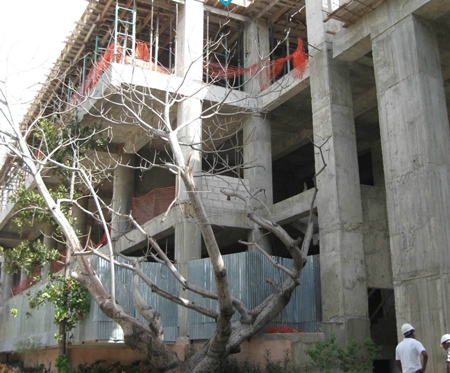Glimmers of hope are coming to the devastated Haitian capital Port-au-Prince and its surrounding cities, as the concrete Royal Oasis hotel rises over a metropolitan area still filled with displaced-persons camps housing hundreds of thousands. Signs of Haiti’s comeback can also be seen in the 105-room Best Western hotel being built within blocks of shanty-covered hillsides.
At least seven hotels are under construction or are in the planning stage in the capital and its surrounding areas, raising hopes that thousands of investors will soon fill their air-conditioned rooms looking to build factories and tourist infrastructure that will help Haiti bounce back from a 2010 earthquake that officials say claimed 300,000 lives. Some damaged hotels are undergoing renovations.
 Building work continues on the Royal Oasis hotel in Port-au-Prince, Haiti. (Photo/OasisHaiti.com)
Building work continues on the Royal Oasis hotel in Port-au-Prince, Haiti. (Photo/OasisHaiti.com)
Together, the projects add up to well over $100 million in new investment and will generate several thousand jobs in a nation still struggling to emerge from years of natural disasters and political turmoil.
In fact, the new hotels are the first significant private-sector construction in Port-au-Prince in the two years since the quake.
“Cautious optimism and deep skepticism” is how economist Claude Beauboeuf describes Haiti’s hotel boom. For people to fill the hotels, he said, it’s important that President Michel Martelly address the problems facing his government, which include an illegal force of armed men openly roaming the country, a string of mysterious police killings and strife with the opposition-controlled Parliament. He also needs a prime minister to replace the outgoing one who resigned after clashing with the president over priorities.
“If he doesn’t address these things, investors will withdraw,” Beauboeuf said, citing Club Med and the Holiday Inn as earlier examples of franchises that left Haiti because of political instability.
The planned hotels in the capital are not aimed at tourists, who avoid gritty Port-au-Prince. Instead, developers are targeting the contractors, foreign aid workers and diplomats for whom finding a room can be a challenge. The Clinton Bush Haiti Fund, led by the previous two U.S. presidents, identified new business-class hotels as key to attracting foreign investors looking for opportunities in Haiti. Similarly, President Martelly has said he wants to make Haiti less dependent on foreign aid and friendlier to outside investments.
One of the biggest foreign investments in Haiti is an industrial park under construction in the north that’s scheduled to begin garment production in September. The giant $300 million Caracol industrial park will be run by South Korean manufacturer Sae-A Trading Co. Ltd. and is expected to bring an initial 20,000 jobs to the remote area. And there are smaller efforts to help Haiti improve production so farmers can better export mangoes, cacao and coffee.
The Haitian capital, which includes several overlapping cities such as Petionville, lost nearly 850 hotel rooms in the quake, according to Tourism Minister Stephanie B. Villedrouin. For more than a year after the disaster, it was often impossible to find a room without months of advance notice.
Villedrouin said all of those hotel rooms will have been replaced by the end of the year.
Several hotel projects are also under way outside the capital, including in the sleepy, picturesque fishing village of Jacmel on the southern coast, and are aimed at what Villedrouin and other government officials hope will become a growing market for tourists willing to overlook the capital and its troubles.
“Haiti is not Port-au-Prince,” the tourism minister said. “Haiti is not the earthquake.”
Even before the catastrophe, only a handful of hotels met international standards of comfort, including the Hotel Montana, the Hotel Villa Creole and the newer Karibe Hotel. These would often fill with journalists, international observers and others during elections or times of crisis, becoming hubs of activity in a city with little in the way of entertainment and where few foreigners venture out at night.
The quake largely destroyed the Montana, though part of it has since re-opened, and extensively damaged the Villa Creole, which remained open after the disaster and is now being renovated. The Karibe was largely unscathed.
Villedrouin said Port-au-Prince officially has a 60 percent occupancy rate but many of the hotels are too rustic for international travelers. The better rooms in the city quickly fill up, with huge demand for the relatively few places with better amenities.
“Right now there’s such demand that the market can absorb several hotels,” said Alejandro Acevedo, an executive for Marriott International, which is building a $45 million, 174-room hotel in partnership with mobile phone company Digicel Group.
Acevedo said even he had to share a room with his boss on a recent visit because of the dearth of hotel space.
“There’s nowhere to stay,” Acevedo said.
Other projects include the $15.7 million Best Western in Petionville that’s due to open this summer. Also in Petionville is the Royal Oasis, a 10-story building that will include an art gallery, three restaurants, a commercial bank and high-end shops. Construction on the Royal Oasis began before the earthquake and is expected to finish by the end of the year.
The project received a $2 million equity investment from the Clinton Bush Haiti Fund along with $275,000 from the Oasis Foundation, a nonprofit group set up by the hotel, to train workers in the hotel industry. It’ll be run by the Spanish firm Occidental Hotel & Resorts.
“This is going to be one of the most palpable signs of modernity emerging from the ashes of the earthquake,” Jerry Tardieu, President and General Director of the Royal Oasis, said from the hotel’s leafy courtyard amid the clang of construction.
The International Federation of Red Cross and Red Crescent Societies is mulling building its own hotel on land it quietly purchased for $10.5 million several months after the earthquake. The money came from donations raised by national Red Cross agencies for quake recovery, causing some to wonder if the money would be better used to house displaced people rather than aid workers.
The Red Cross has said little about the project since it was reported in recent weeks, saying only that it is under consideration.
Many people in Haiti welcome the new hotels just as they do any new investments that will bring jobs to a country where more than half the adult population is unemployed or underemployed and survive on less than $2 a day. But some say Haiti should first care for the 500,000 people still living in makeshift camps.
“It’s nice to build hotels to bring tourists but first you need to think of your citizens,” said Ben Etienne, a 36-year-old resident of a hilly encampment in Peguyville that fills with mud during Haiti’s rainy season. “I don’t have a problem if the tourists come but the money needs to come into the country for the people.”
Tardieu said the new hotels will help more people get out of the camps by giving them jobs to pay for rent on homes being rehabilitated by government and nonprofit organizations.
He noted that 600 people have been employed in the Royal Oasis’ construction and that another 250 to 300 full-time jobs will be created after it opens.
“There need to be Haitian women and men who dare to invest,” he said, “who dare to have a vision of modernity for their country and do not cave in to the cliche that Haiti is only a country where efforts have to be geared toward short-term relief humanitarian work.”




